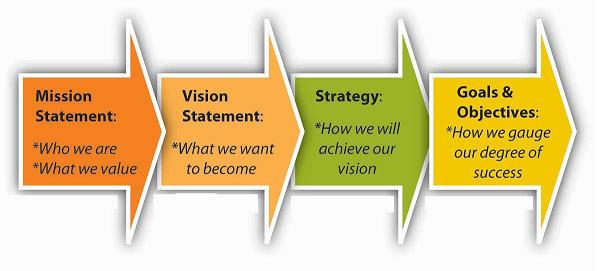Vision Statement of a Company
Business success almost always begins with a vision, a perception of marketplace needs and the methods an organization can use to satisfy them. Vision serves as the target for a firm’s actions, helping to direct the company toward opportunities and differentiating it from its competitors.
Vision is a concept, that refers to one’s mental image of the future. Vision refers to the optimum future state of affairs that one can imagine for an individual or for an institution. (Wallace, Engel et al, 1997)
A vision consists of three characteristics: 1) an organization’s fundamental reason for existence beyond just making money or providing more service 2) its timeless unchanging core values, and 3) a “big picture” aspiration for its own future. The vision of an organization defines who and what the organization is about, why it exists, and where it is going in the grand scheme of things.
A vision is the guiding theme that articulates the nature of the business and its intentions for the future. These intentions are based on how the management believes the environment will unfold and what the business can and should be in the future. A vision has the following characteristics:
- Informed — rooted in a deep understanding of the business and the forces shaping the future,
- Shared and created through collaboration,
- Competitive — creates an obsession with winning throughout the organization, and
- Enabling — empowers individuals to make meaningful decisions about strategies and tactics.
A vision must be able to inspire people by making a powerful statement in simple terms so that people at all levels can relate to it.
A vision gives direction for the desired future scope and position of a company:
- It deals with the future.
- It is ambitious.
- It is expressed in simple terms – understandable at all levels of the company.
- It does not deal with details, but is concrete.
- It does not deal with solutions.
- It opens space for creative forward thinking, based on an (emotionally appealing) “picture”
- It is not a secret plan but an open declaration.
- A vision serves to create a common mind set throughout the organization.
- It helps to mobilize people.
- It creates momentum and initiative: “Am I doing enough to increase the fit of my business with the corporate vision?”
Mission Statement of a Company
Mission statement of a firm is the expression of its strategic intent. Strategic intent is the fundamental ends a firm wants to pursue. Mission statement also reveals the self-concept of the firm. Thus, the mission of the business is a qualitative statement of overall business position that summarizes the key points with regard to products, markets, geographic locations and unique competencies. A mission statement abstracts the important points to guide the development of business. Besides others there are two pieces of information that must be contained in the mission statement. Clear definition of current and future business scope and second the unique competencies that distinguish the firm from others in the same industry.
Following is the detailed description of the contents of the mission statement;
- Core values: It is the beliefs which guide the behavior of the firm. This is to be encoded in the mission statement so that the employees understand that it has to be followed at any cost.
- Core purpose: It is the fundamental end for which an organization exists. It is the very reason of the existence of the firm in the market.
- BHAG: It represents Big Hairy Audacious Goal. This implies, that the mission statement should be organized in such a manner that it fires up the competitive zeal of the employees. In their celebrated article, Garry Hamel and C.K.Prahlad state that rather than trimming ambitions to match available resources, managers should instead leverage resources to reach seemingly unattainable goals. This challenge is at the heart of a proper mission statement.
- Vivid description of future: A mission statement is grossly incomplete without the clear definition of the expected future business scope. This has got two dimensions; business and ethical. Business dimensions includes;
- Scope of the firm: The description of current and future market scope, product scope, geographical reach scope and customer scope.
- Positioning strategy: This explains on what basis the firm wants to compete and how the firm wants itself to be known in the market. There are two ways to create value for money for shareholders- cost leadership strategy and product differentiation strategy. The image of the firm will depend on this positioning strategy.
- Responsibilities to the stakeholders: Here the firm has to spell out how it wants to treat its different stakeholders.
